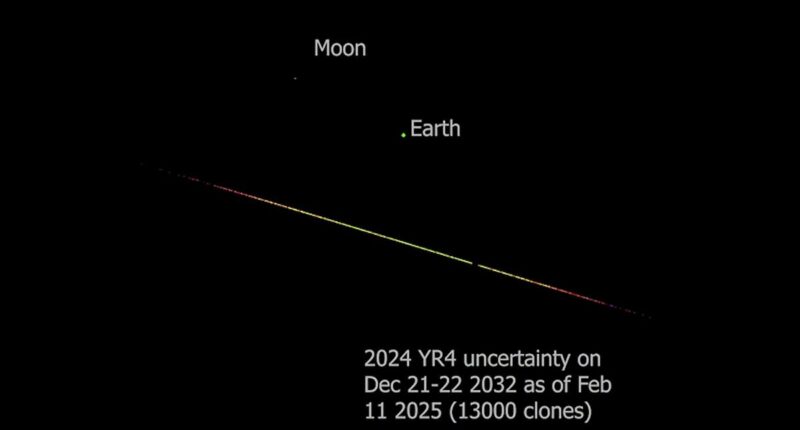
A terrifying new animation has revealed the projected path of the ‘city-destroying’ asteroid heading towards Earth.
And it suggests that Earth isn’t the only object in the firing line.
According to Dr David Rankin, operations engineer for the University of Arizona’s Catalina Sky Survey, the moon is also at risk of being hit.
Dr Rankin calculated the route that the asteroid, 2024 YR4, is most likely to take.
His calculations indicate that 2024 YR4 currently has a 2.1 per cent, or one in 48, chance of colliding with Earth on December 22, 2032.
This is actually slightly less than previous estimates, which suggested there was a 2.3 per cent (one in 43) chance of impact.
Meanwhile, the scientist predicts there’s a roughly 0.3 per cent (one in 333) chance of 2024 YR4 hitting the moon.
If the asteroid were to collide with Earth, it would generate an explosion equal to 15 million tons of TNT, which is 100 times more powerful compared to the atomic bomb that was deployed on Hiroshima in World War II.
The asteroid was first detected by the NASA-funded Asteroid Terrestrial-impact Last Alert System (ATLAS) station in December last year.
It soon set alarm bells ringing as NASA almost doubled the probability of an impact with Earth from 1.2 per cent to 2.3 per cent.
Even though the likelihood of this happening has slightly decreased, asteroid 2024 YR4 remains the most significant threat to Earth as it has a greater than one percent chance of impact.
However, Dr Rankin’s calculations present a chilling new possibility that the asteroid could collide with the moon instead.
In a post on BlueSky, Dr Rankin revealed that there was a roughly 0.3 per cent chance of 2024 YR4 hitting the moon.
Due to the absence of an atmosphere to impede its descent, the asteroid would crash into the moon’s surface at an incredible velocity of 31,000 miles per hour (50,000 kilometers per hour).
The collision would unleash an explosion 343 times the size of the atomic bomb dropped on Hiroshima and carve out a crater up to 1.2 miles (2km) across.
Should it hit the moon, it is most likely to land in the region stretching south from the Mare Crisium, a large plain of solidified lava, to the crater Tycho.
This could be concerning since this would place the impact on the side of the moon facing Earth, potentially exposing us to a shower of lunar shrapnel.
Thankfully, experts say that the Earth likely wouldn’t be harmed by any impact which occurs on the moon.
Dr Rankin told New Scientist: ‘There is the possibility this would eject some material back out that could hit the Earth, but I highly doubt it would cause any major threat.’
Unlike a large object such as 2024 YR4, these smaller pieces of debris should burn up harmlessly in the atmosphere creating nothing more than a particularly bright meteor shower.
In fact, some experts suggest that the collision between the asteroid and the moon could create a truly spectacular display.
Gareth Collins, a professor of planetary science at Imperial College London, told New Scientist: ‘The impact flash of vaporised rock would be visible from Earth, even in the daytime.’
That means any keen stargazers on Earth could see the moment the asteroid detonates on the lunar surface with the naked eye.
However, it is currently seven times more likely to hit Earth rather than the moon.
These probabilities are likely to change in the future as scientists gather more information about the asteroid’s orbit.
The current estimates for 2024 YR4’s orbital path, speed, and size come from hundreds of images taken by powerful telescopes all around the world.
However, over such a short period of time, it is difficult to precisely predict where the asteroid will travel.
While astronomers hope that the probability of an impact will rapidly fall towards zero, a direct collision with Earth cannot be ruled out.
Recently, NASA and the European Space Agency (ESA) made the emergency decision to use the James Webb Space Telescope (JWST) to take more accurate measurements.
The JWST will record the heat emitted by the asteroid using its infrared sensors which will give a more accurate estimate for its size.
A team of ESA scientists will make one observation in March when the asteroid reaches its peak brightness and another in May as it travels away from Earth.
This will be the last chance to observe 2024 YR4 before it becomes too dim to see from Earth until it returns again in 2028.
Those observations will be critical for determining whether the world’s space agencies need to take action to divert its course.
NASA’s Double Asteroid Redirection Test (DART) mission demonstrated how a space rock could potentially be thrown off a collision course with Earth by crashing a spacecraft into it.
Using a similar strategy to knock 2024 YR4 off its predicted orbit is one possible way that planetary defence organisations could protect Earth.
However, with only eight years until the asteroid arrives, some scientists have cast doubt on the plan to deflect the killer asteroid.
In a post on X, Dr Robin George Andrews, a volcanologist and author based in London, points out that we ‘have less than eight years to potentially deal with it’.
‘You need 10 years or more to build, plan and execute an asteroid deflection mission,’ he said.

















